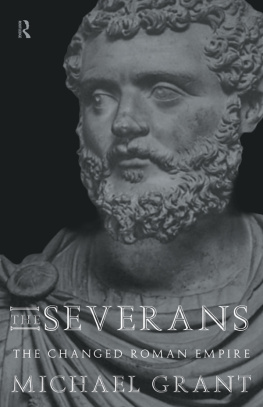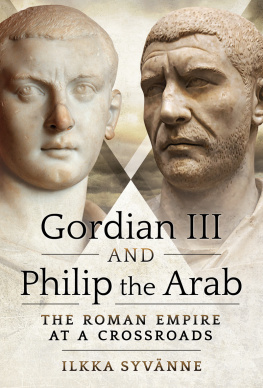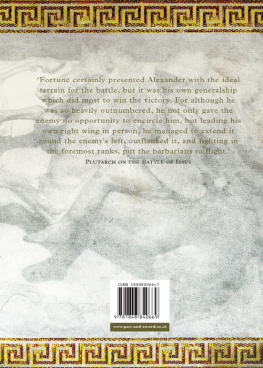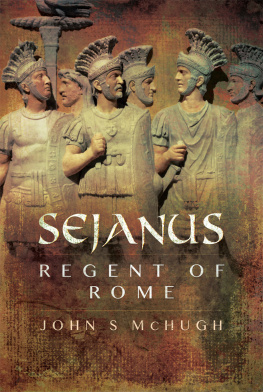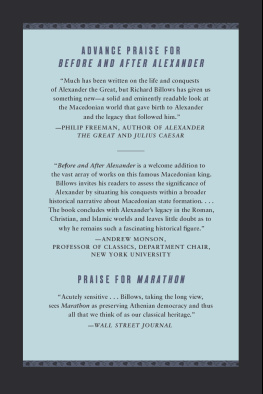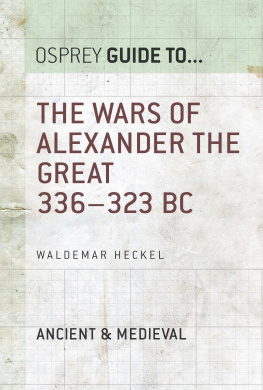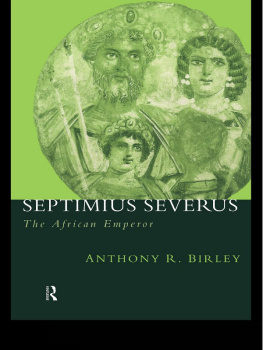
Emperor Alexander Severus
Emperor Alexander Severus
Romes Age of Insurrection, AD 222235
John S. McHugh
First published in Great Britain in 2017 by
Pen & Sword Military
an imprint of
Pen & Sword Books Ltd
47 Church Street
Barnsley
South Yorkshire
S70 2AS
Copyright John S. McHugh
ISBN 978 1 47384 581 7
eISBN 978 1 47384 582 4
Mobi ISBN 978 1 47384 583 1
The right of John S. McHugh to be identified as Author of this work has been asserted by him in accordance with the Copyright, Designs and Patents Act 1988.
A CIP catalogue record for this book is available from the British Library.
All rights reserved. No part of this book may be reproduced or transmitted in any form or by any means, electronic or mechanical including photocopying, recording or by any information storage and retrieval system, without permission from the Publisher in writing.
Pen & Sword Books Ltd incorporates the Imprints of Pen & Sword
Aviation, Pen & Sword Family History, Pen & Sword Maritime,
Pen & Sword Military, Pen & Sword Discovery, Pen & Sword Politics, Pen & Sword
Atlas, Pen & Sword Archaeology, Wharncliffe Local History,
Wharncliffe True Crime, Wharncliffe Transport, Pen & Sword Select,
Pen & Sword Military Classics, Leo Cooper, The Praetorian Press,
Claymore Press, Remember When,
Seaforth Publishing and Frontline Publishing.
For a complete list of Pen & Sword titles please contact
PEN & SWORD BOOKS LIMITED
47 Church Street, Barnsley, South Yorkshire, S70 2AS, England
E-mail:
Website: www.pen-and-sword.co.uk
List of Illustrations
Marble bust of Emperor Septimius Severus in the Altes Museum, Berlin.
Cast of a bust of Emperor Caracalla in the Pushkin Museum.
Denarius showing Empress Julia Maesa.
Statue of Julia Domna in the Rmisch-Germanisches Museum, Cologne.
Gold aureus of Emperor Macrinus ( AD 217218).
Cast of a statue of Julia Mamaea.
Denarius of Julia Mamaea struck in AD 228.
Bust of Emperor Elagabalus in the Capitoline Museum, Rome.
A gold aureus of Emperor Elagabalus struck c . AD 218219 in Antioch.
Altar dedicated to the god Elagabalus by Gaius Julius Avitus Alexianus c . AD 196200, housed in the Rmisches Museum, Augsburg.
Bronze head of Emperor Alexander Severus from the Archaeological Museum of Dion.
Marble bust of Emperor Alexander Severus in the Louvre.
Colossal head of Alexander Severus in The Hermitage, St Petersburg.
Shattered bust of Alexander Severus.
Bust of Emperor Maximinus Thrax in the Capitoline Museum, Rome.
Gold multiple of a cuirassed Alexander Severus struck c . AD 230 from the Treasury of Tarsus.
Bronze sesterces of Alexander Severus minted to celebrate the profectio of the emperor as he embarked from Rome to the East.
A sesterces of Alexander Severus minted in Rome in AD 229.
Medallion of Alexander Severus from AD 224.
Sesterces of Alexander Severus struck in AD 231.
Tetradrachum from Alexandria, Egypt.
The fountain made of Aswan granite in the via degli Staderari, Rome.
The monumental Nymphaeum of Alexander Severus.
One of two marble statues that stood on the Nymphaeum of Alexander Severus until the late sixteenth century.
Relief showing the Praetorian Guard in full battle panoply in the Louvre-Lens.
Marble relief of a Praetorian at the Antikensammlung, Berlin.
Relief from the Grand Ludovisi Battle Sarcophagus depicting Romans conquering barbarians, from the mid-third century AD .
Relief from the Grand Ludovisi Battle Sarcophagus depicting a Roman soldier with a captive barbarian from the mid-third century AD .
Aqueduct Alexandrina, Rome.
The temple at Cuicul (Djemila), viewed from the forum.
The theatre of Lepcis Magna.
Arches surrounding the Forum Severiarum at Lepcis Magna decorated with Gorgons heads.
View of the caldarium of the Baths of Caracalla, Rome.
Remains of a private house converted into a Christian Church at Dura Europas.
Ruins of a temple from Hatra.
A coin of the usurper Uranius, showing the conical stone representation of the god Elagabal housed in its temple in Emesa.
Statue of Jupiter Dolichenus from Carnuntum, now in the Museum Carnuntinum.
Relief of Ardashir from Naqsh-e-Rostam (Iran).
The remains of a Zoroastrian fire temple from Isfahan, Iran.
Reconstruction of the Roman palisade and ditch of the Upper German limes near Saalburg, Germany.
List of Maps
Map 1. The Roman Empire.
Map 2. Central Rome.
Map 3. The Limes in Germany, Second Century AD .
Map 4. The Roman Empire in the Early Third Century.
Map 5. The Eastern Frontier of the Roman Empire c. AD 230.
Maps

Map 1. The Roman Empire. (Wikimedia Commons)

Map 2. Central Rome. (Wikimedia Commons)
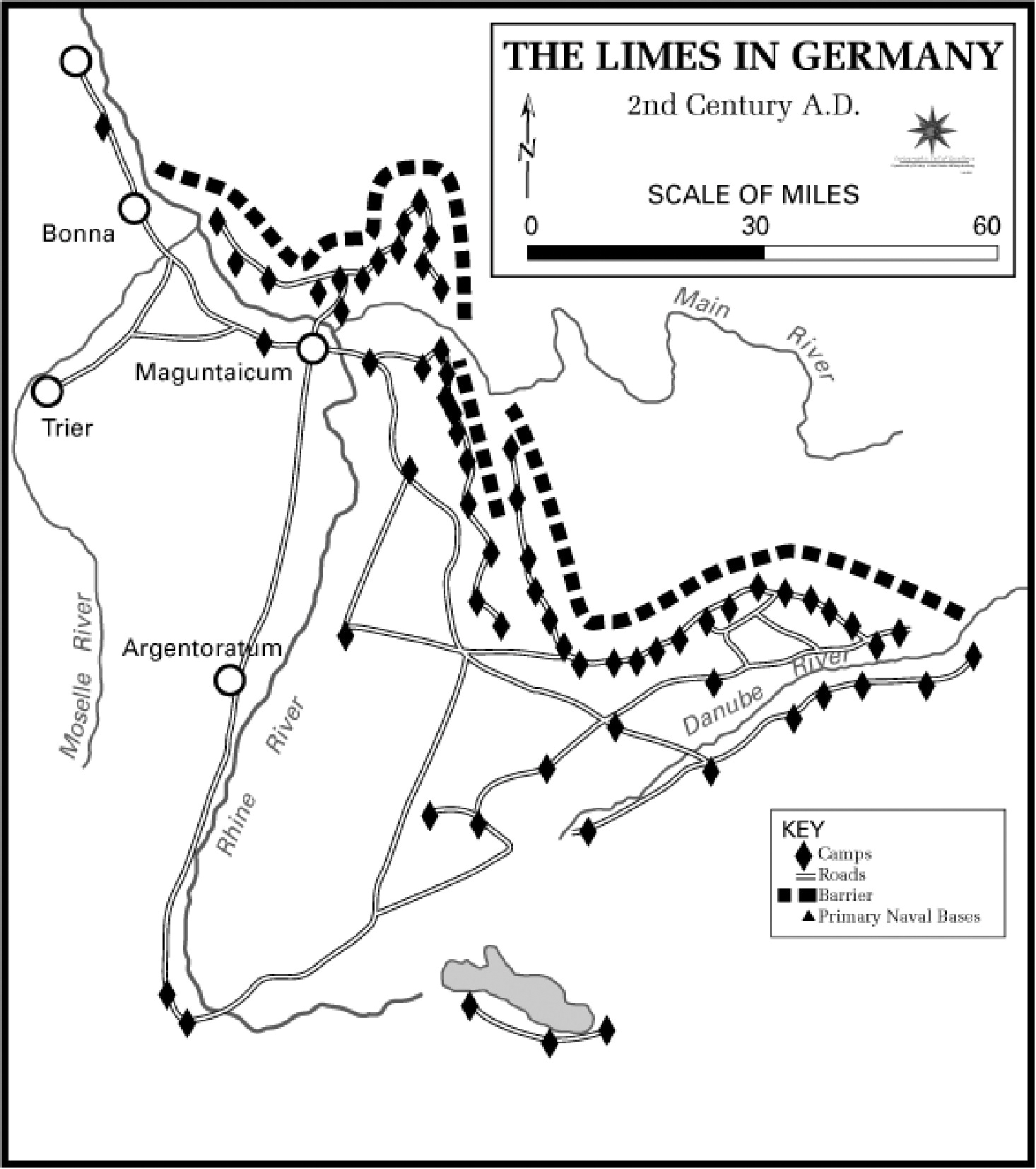
Map 3. The Limes in Germany, Second Century ad. (Wikimedia Commons)

Map 4. Sketch Map of the Roman Empire in the Early Third Century, Based on Birley (1988). (Paul Pearson)

Map 5. Sketch Map of the Eastern Frontier of the Roman Empire c. AD 230. (Paul Pearson)
Family Tree
The family of Alexander Severus
Chapter 1
Murderers and Usurpers AD 192211
the lot of all Emperors is necessarily wretched, since only their assassination can convince the public that conspiracies against their lives are real
T hese prophetic words were uttered by the Emperor Domitian, murdered in AD 96 by his own friends, his amici , and imperial freedman in a palace conspiracy that probably included his wife and Praetorian Prefects. As the desperate emperor was stabbed repeatedly by his assailants, he attempted to reach the dagger that he kept under his pillow, but he found that its blade had been removed by his closest advisor. His successor, M. Cocceius Nerva, one of his closest amici , was named emperor on the same day, suggesting, at the very least, prior knowledge of the plot.
This reign heralded the Antonine Age of stability, peace and prosperity that ended with the Marcomannic Wars from AD 166, the outbreak of the Antonine Plague and the murder of Commodus in AD 192. Nerva and his successors, Trajan, Hadrian, Antoninus Pius, Lucius Verus and Marcus Aurelius, all died of natural causes. Commodus, however, was the victim of another well-planned palace plot involving his closest amici , including the Praetorian Prefect tasked with ensuring his personal safety, his consort Marcia and his cubicularius , the freedman responsible for the imperial bedchamber. The Antonine emperors had faced plots, barbarian incursions and military revolts, but, apart from Commodus, had survived and prospered. Yet from AD 192 until the reign of Diocletian in AD 284, there were thirty-one emperors, of whom only three Septimius Severus, Claudius Gothicus and possibly Carus did not die violently. In this age of insurrection, placing power into the hands of a capable commander or politician provided them with the opportunity for revolt or murder. Yet at the same time the empire faced invasions along its considerable borders. An emperor could only be in one place at once. In this period of nearly 100 years, twelve emperors were murdered either by their own troops or the Praetorian Guard, whilst six were assassinated in what can loosely be termed palace conspiracies, three executed by successful usurpers, two killed in battle with rivals, another two either killed or captured by external enemies, one committed suicide, and of the three who died naturally, one died of the plague. One wonders why the imperial throne appeared so attractive.


